
Accelerated corrosion testing
Accelerated corrosion testing is indispensable for material selection, quality control and for both initial and residual life time prediction of bare and painted metallic, polymeric, adhesive and other materials in atmospheric exposure conditions. It is widely used in the automotive, aerospace, building, off-shore and infrastructure applications.
Beside generally known Neutral Salt Spray (NSS), Acetic Acid Salt Spray (ASS) and Copper-Accelerated Acetic Acid Salt Spray (CASS) tests, a number of modern cyclic corrosion tests including wet and dry phases has been developed. Because of more realistic conditions, their results correlate better to those from natural exposures and thus provide significantly improved predictive ability. The traditional NSS and its variants are more suitable for quality control.
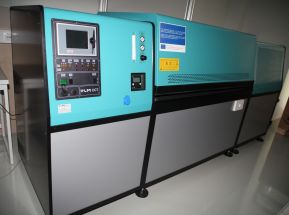 |
 |
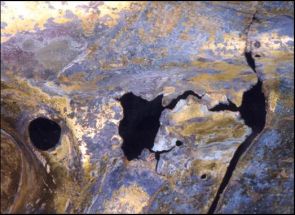 |
In our advanced automated corrosion chambers with temperature control from –40 to 80 °C and control of the relative humidity (RH) from about 20 to 100 %, we are able to perform tests according to most international, national and industrial standards for commercial applications and research purposes.
Cyclic corrosion tests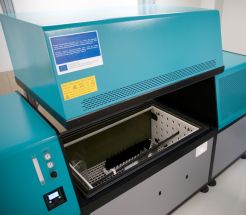
-
VDA 233-102, SEP 1850 (N-VDA)
This test has been created jointly by a group within the German Association of the Automotive Industry, VDA, with the aim to serve for the development of new materials and coatings. It allows for the assessment of the corrosion behaviour of components and of the corrosion protection provided by coating systems for applications in the automotive industry. The accelerated test covers in particular the delamination around a defined artificial defect in a coating as well as surface and cut edge corrosion on special test panels, bonding specimens or components. This laboratory-scale cyclic corrosion test is also suitable for assessing perforation corrosion in flanged areas or gaps and of unpainted surfaces. This method induces corrosion processes and generates reproducible corrosion patterns which correlate well with the results obtained in natural weathering tests and driving operation. In particular, the corrosion patterns for steel, galvanised steel and aluminium closely reflect real-life phenomena. The test method is based on real corrosive climate conditions and delivers differentiated results for a large number of uses in automotive applications.
- Conditions: Complex test including a variety of technical phases such as a salt spray phase (1 wt.% NaCl solution, pH neutral), wet and dry cycles at temperatures up to 50 °C and a freezing phase at –15 °C. Typical duration: 6 weeks.
-
VW PV 1210 (Volkswagen Group)
This method is designed for corrosion testing of automotive materials conducted on completely painted bodies, body panels, assemblies and add-on parts with differing corrosion protection coatings. It serves to monitor and evaluate corrosion behaviour or corrosion protection measures when exposed to static load. - Conditions: 5-day cycle comprising of NSS (35 °C, 5 wt.% NaCl solution), dry phase and humid phase at 40 °C and 100% RH followed by 2-day rest at laboratory temperature. Typical duration: 3, 6, 12 or 18 weeks.
-
VW PV 1209 (Volkswagen Group)
Conditions: Combination of the PV 1210 with cycles of rapid variations of temperature and RH from –40 to 80 °C and from 30 to 80 % RH. The chloride solution used for salt spraying is modified and contains 4 wt.% NaCl and 1% CaCl2.
The high/low temperature cycle is designed for testing vehicle parts in the engine compartment in view of e.g. susceptibility to cracks, deformation, separation of the composite material, etc. -
Nissan CCT I (CCT 1)
Conditions: Repetition of 8-hour cycles with 4 hours of NSS (35 °C, 5 wt.% NaCl solution), 2 hours of drying at 60 °C and RH < 30 % and 2 hours of moistening at 50 °C and 95 % RH. Typical duration: 500 to 1500 hours. -
Nissan CCT IV (CCT 4)
-
Conditions: Repetition of 24-hour cycles with 4 hours of NSS (35 °C, 5 wt.% NaCl solution), 2 hours of drying at 60 °C and RH < 30 % and 2 hours of moistening at 50 °C and 95 % RH followed by 5 wet/dry cycles at constant temperature of 60 °C.
-
Renault ECC1 D17 2028
Conditions: Test performed at 35 °C comprising wet (90 % RH) and dry (55 % RH) phases. Sodium chloride solution with 1 wt. % NaCl at pH 4 is sprayed over samples during 30 minutes once a day. Typical duration: 6 weeks. -
PSA TCAC D13 5486 (Peugeot, Citroën)
Conditions: Salt spray with 1 wt.% NaCl solution at pH 4.1 and wet and dry cycling at a constant temperature of 35 °C. -
JSAE JASO M 609
A Japanese procedure designed for bare, metallic coated and painted steel panels for use in the automotive industry. - Conditions: Repetition of cycles of salt spray with neutral 5 wt.% NaCl solution at 35 °C (2 hours), drying phase at 60 °C and at 20–30 % RH (4 hours) and wetting condensing phase at 50 °C and at 95 % RH (2 hours). Typical duration: 30–180 cycles (240–1440 hours)
-
VDA 621-415
Conditions: 1 day of NSS (35 °C, 5 wt.% NaCl solution), 4 days of wet (40 °C / 98 % RH) and dry (23 °C / 50 % RH) cycling, 2 days at laboratory temperature. Typical duration: 10 weeks.
ISO 16701 (CCT)
Conditions: Humidity cycling between 95 and 50 % RH at 35 °C with 6-hour salt spray sub-cycle carried out twice a week. The sub-cycle consists of 3 cycles of 15-minute spraying with a 1 wt.% NaCl solution acidified to pH 4.2 followed by a 105-minute period of wet stand-by.
The low pH level of the spraying solution simulates acidic precipitation present in industrialized areas.
-
ASTM D5894
Cyclic corrosion and UV exposure of paints on metal using alternating periods of exposure in two different cabinets: a cycling salt spray/dry cabinet and a fluorescent UV/condensation cabinet.
Conditions: The fluorescent UV/condensation cycle is 4-hour UV at 0.89 W m–2 nm–1 at 340 nm and at 60 °C and 4-hour condensation at 50 °C. The salt spray/dry chamber runs a cycle of 1-hour salt spray at ambient temperature and 1-hour dry-off at 35 °C. The salt spray electrolyte contains 0.05 wt.% sodium chloride and 0.35 wt.% ammonium sulphate. -
ASTM G 85, Practice A2 (Cyclic Acidified Salt Fog Testing)
Modifications of NSS with humidity cycling and altered spraying solution.
Conditions: Six-hour repetitive cycles of 45 minutes of spraying with acidified 5 wt.% NaCl solution, 120 minutes of drying and 195 minutes of exposure to high RH. -
ASTM G 85, Practice A3 (Acidified Synthetic Sea Water (Fog) Testing)
Modifications of NSS with humidity cycling and altered spraying solution. This test is particularly useful for production control of exfoliation-resistant heat treatments for the 2000, 5000, and 7000-series aluminium alloys. It is also applicable to developmental studies of varying heat treatment parameters to determine effect on corrosion behaviour. For this purpose, a temperature of 49 °C is recommended for the exposure zone. For testing organic coatings on various metallic substrates, an exposure zone temperature of 24 to 35°C may be used since temperatures in excess of 35°C frequently result in paint blistering.
Conditions: Two-hour repetitive cycles of 30 minutes of spraying with acidified artificial sea water and 90 minutes of exposure to elevated RH. -
ASTM G 85, Practice A5 (Dilute Electrolyte Cyclic Fog/Dry Test, Prohesion)
Prohesion is a shortened form of “protection is adhesion”. It is designed for paints on steel and believed to be more representative of outdoor corrosion than NSS. Prohesion testing has been found especially useful for industrial maintenance coatings.
Conditions: Short cycles of 1-hour spraying with a diluted solution of sodium chloride (0.05 wt.%) and ammonium sulphate (0.35 wt.%) at pH 5–5.4 and 1-hour dry-off. -
ISO 20340
This standard deals with performance of heavy-duty paint systems designed for protection of off-shore and similar structures.
Conditions: Each week cycle includes 3-day exposure to intermittent UV irradiation (4 hours, 60 °C) and water condensation (4 hours, 50 °C) according to ISO 11507, 3-day exposure to NSS and 1-day exposure at –20 °C. Typical duration: 25 weeks.
Some other standard tests such as Volvo STD 1027 (Scania STD 4233), Suzuki SAE J2334, GM 9540P, Ford CETP 00.00-L-467 can be performed upon demand.
Salt spray tests (NSS, ASS, CASS)
- EN ISO 9227
- EN ISO 7253
- ASTM B 117
- BS 7479
- NFX 41-002
- JIS Z 2371
- IEC 60068-2-11
- MIL-STD-810, Test Method 509.5
- MIL-DTL-5541F
- ASTM G 85, Practice A1
NSS (5 wt.% solution of NaCl at pH 6.5–7.2 sprayed continuously over sample surface) is the oldest and still most widely used accelerated test recommended for corrosion assessment of metals and alloys, metallic coatings, conversion layers and organic coatings on metal substrates. ASS (5 wt.% NaCl acidified by acetic acid to pH 3.1–3.3) and CASS (further addition of cupper (II) chloride) are used for decorative coatings of copper, nickel and chrome or nickel and chrome and coated aluminium.
Moist SO2 (Kesternich) tests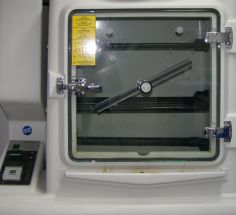
- EN ISO 3231
- ISO 6988
- ASTM G 87
- ASTM G 85, Practice A4
- DIN 50 018
Kesternich testing simulates industrial chemical exposure. Parts or panels are placed inside a chamber where SO2 is generated and high humidity maintained.
Water condensation tests
- EN ISO 6270
- DIN 50017 KK
- ASTM D2247
- ASTM D1735
UV /water condensation weathering
- ISO 11507
- IEC 61345
- EN 13523-10
- ASTM D4587
Combined tests
ISO 12944-6
Procedures for performance testing of painted steel structures aimed for application in atmosphere with defined corrosivity are described.
Conditions: Combination of ISO 2812-1 (chemical resistance), ISO 2812-2 (water immersion), ISO 6270 (water condensation) and ISO 7253 (NSS).
We can help with selection of the optimal procedure in view of the required product or structure lifetime and service conditions.
We provide complete service including sample preparation, intermediate evaluations, e.g. for the assessment of time to red rust appearance, final evaluation and documentation of actual test conditions. The extent of intermediate and final assessment can be tailored according to the customer needs, following standards such as EN ISO 4628 on the evaluation of degradation of organic coatings (rusting, cracking, chalking, blistering, flaking, filiform corrosion, delamination), or particular customary procedures. Our analytical, electrochemical, metallographic and other equipment allows for in-detail analysis of corrosion degradation in terms of uniformity, mean and maximal pit depth, composition of corrosion products, paint delamination morphology and mechanism, paint adhesion (EN ISO 2409, ASTM D3359), paint water uptake, hem flange corrosion, etc.
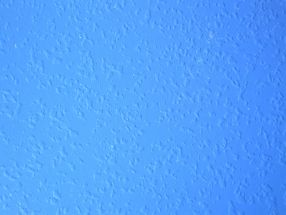 |
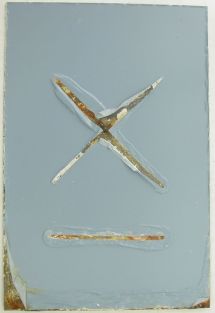 |
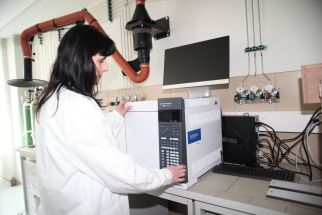 |
In addition to standard tests, we offer the possibility to develop customary tests according to your specific needs. A battery of dc and ac electrochemical methods and immersion tests in combination with procedures listed above constitute a strong basis for proper assessment of material stability.
Service data are often required for confirmation of laboratory results. We can oversee field exposures at well-managed natural weathering sites in the Czech Republic, Europe, USA, China and other countries. The accelerated outdoor test by intermittent spraying of a salt solution according to ISO 11474, the SCAB (Simulated Corrosion Atmospheric Breakdown) test, can also be carried out.
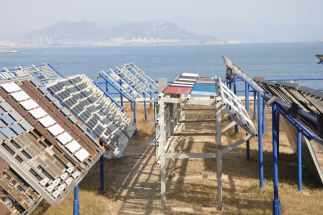
Accelerated corrosion testing will help you reducing detrimental effects of corrosion.
About us:
Technopark Kralupy is a spin-off of The University of Chemistry and Technology Prague serving the Czech and international industry in the field of building chemistry and similar subjects since 2015.
Contact:
Department of Metallic Construction Materials
Technopark Kralupy of The University of Chemistry and Technology, Prague
Czech Republic
kovy@technopark-kralupy.cz
Phone: +420 220 446 104, +420 723 242 413


